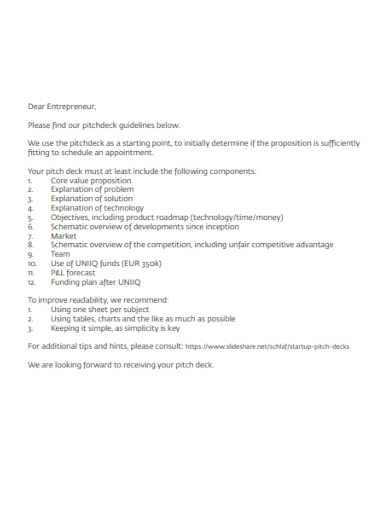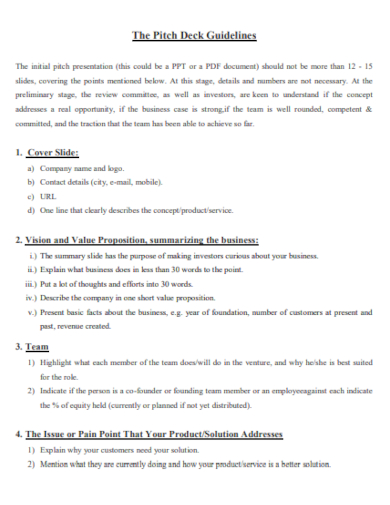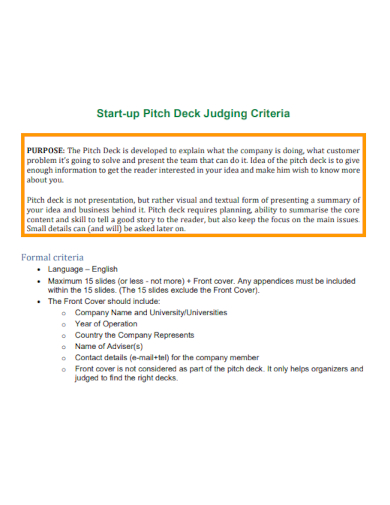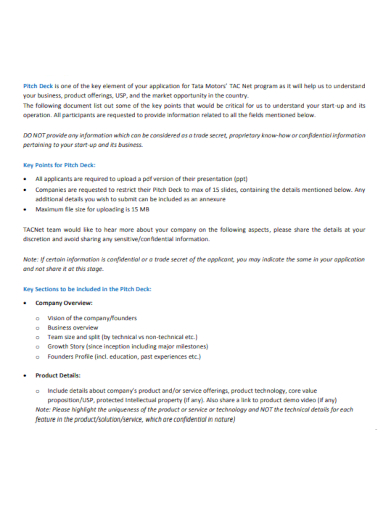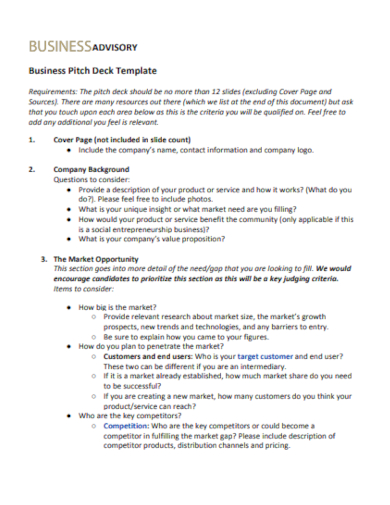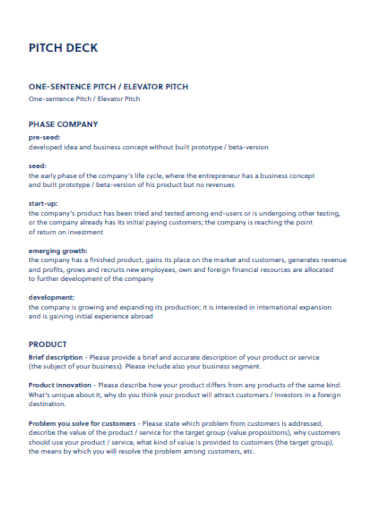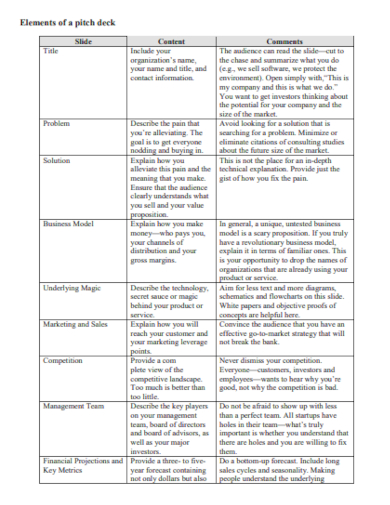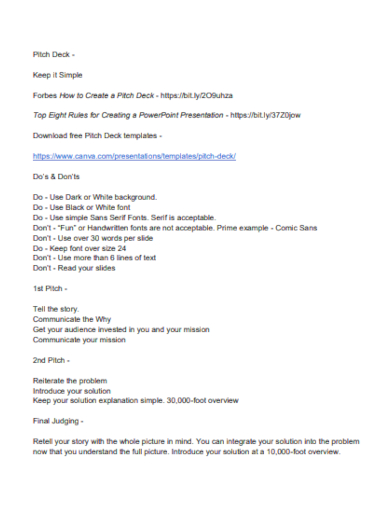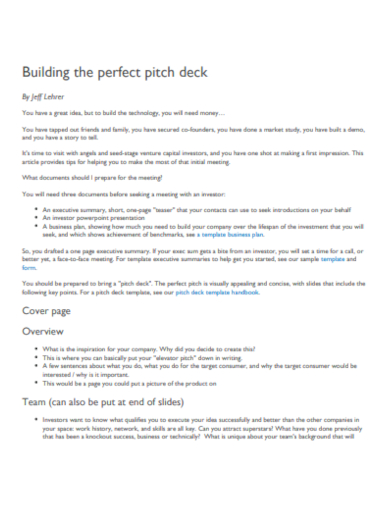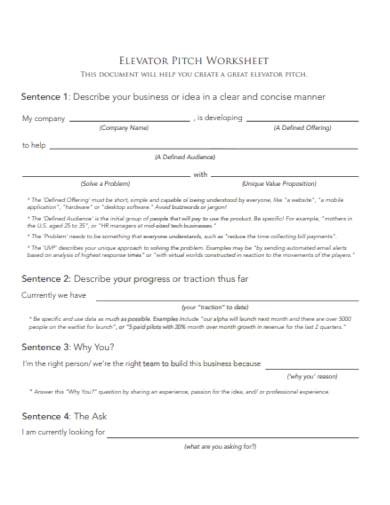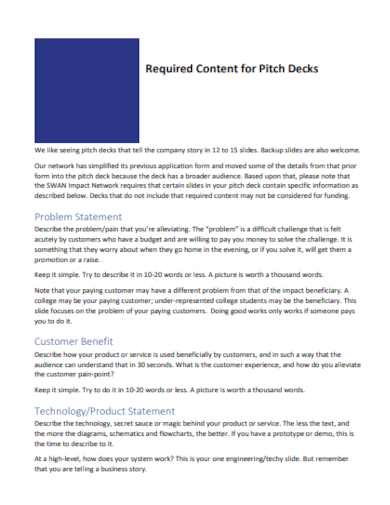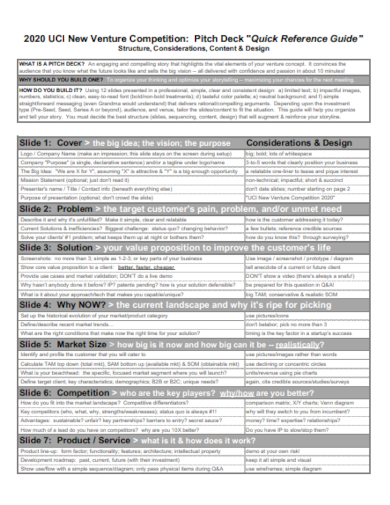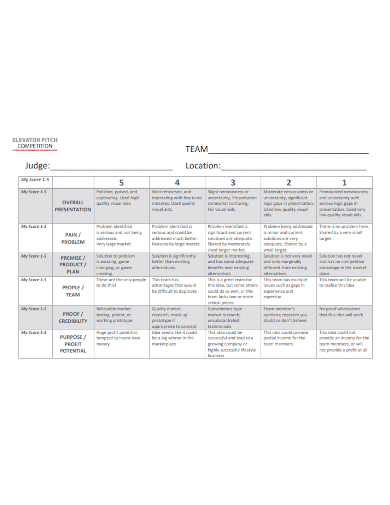Embark on your startup journey with confidence using our Pitch Deck Template. This meticulously curated presentation research framework is your key to engaging investors effectively. In today’s fast-paced entrepreneurial world, a compelling pitch deck presentation distinguishes the best from the rest. Catering to both new startups and established enterprises, our template is designed to articulate your vision, underscore your value, and demonstrate your venture’s viability. Harness its power to captivate your audience and secure the backing you deserve!
20+ Pitch Deck Samples
1. Pitch Deck Template

2. Restaurant Pitch Deck Template

3. Medical Pitch Deck Template

4. Product Pitch Deck Template

What is a Pitch Deck?
A pitch deck, in its essence, is a visual presentation that entrepreneurs and startup founders use to provide investors, stakeholders, or potential partners with a brief overview of their business plan. Traditionally used during face-to-face or online meetings, a pitch deck serves as both a communication tool and a way to present your business in the best possible light.
Purpose of a Pitch Deck:
The primary goal of a pitch deck is to captivate and convince. For startups, especially, it’s often the first point of detailed interaction with potential investors. Given the limited timeframe during such meetings, the pitch deck should be concise yet comprehensive, allowing the presenter to guide viewers through the business’s essential facets. A well-crafted pitch deck has the power to secure funding, attract partners, or validate a business idea by gauging interest.
Key Elements of a Pitch Deck:
While the content can vary based on the business and its industry, a typical pitch deck often includes the following elements:
- Introduction: A brief intro of the founder(s) and the mission of the company.
- Problem Statement: An overview of the problem or gap in the market that the startup aims to address.
- Solution: A description of the product or service that the startup offers as a solution to the identified problem.
- Business Model: An insight into how the startup plans to make money, detailing revenue streams and pricing strategies.
- Market Analysis: Information about the target market size, growth potential, and the startup’s intended market share.
- Marketing and Sales Strategy: An outline of how the startup plans to attract and retain customers.
- Competitive Landscape: A look at the competition and what differentiates the startup from them.
- Financial Projections: Predicted financial performance over the next few years, showcasing viability.
- Team: Profiles of key team members, highlighting their experience and roles.
- Ask: Clearly stating what the startup is seeking, whether it’s funding, partnerships, or other resources.
Importance of Design and Storytelling:
Beyond the content, the design and flow of the pitch deck are crucial. Given its visual nature, compelling graphics, consistent branding, and a logical progression can significantly enhance the presentation’s effectiveness. Storytelling, too, plays a pivotal role. A memorable narrative can resonate more profoundly with investors, making them more likely to invest emotionally before they decide to invest financially.
In the dynamic world of startups and venture capital, a pitch deck is an indispensable tool for entrepreneurs. While the content is certainly king, the way it’s packaged and presented can significantly influence outcomes. A compelling pitch deck does more than just inform; it captivates, convinces, and converts potential skeptics into staunch supporters. In this regard, it’s not just a presentation but a potent weapon in an entrepreneur’s arsenal, wielding the power to unlock doors to growth and success.
5. Professional Pitch Deck Template
6. Value Proposition Pitch Deck
7. Sample Pitch Deck Template
8. Pitch Deck Presentation
9. Startup Pitch Deck Template
10. Product Pitch Deck Sample
11. Business Advisory Pitch Deck
12. Elevator Pitch Deck Template
The Purpose of a Pitch Deck
In the bustling realm of entrepreneurship, where ideas teem and innovation thrives, the ability to communicate one’s vision concisely and compellingly is paramount. Enter the pitch deck—a tool that has become indispensable for startups and established businesses alike. But what exactly is the purpose of this often-talked-about presentation?
A Concise Introduction to Your Vision:
At its core, a pitch deck serves as a brief, visual representation of your business plan or idea. It’s designed to provide potential investors, partners, or stakeholders with a snapshot of your business, conveying the essence of what you aim to achieve and how you plan to do it. In a world where attention spans are dwindling, the pitch deck’s conciseness works to its advantage, ensuring that your audience grasps the core of your proposition quickly.
To Attract and Secure Funding:
Perhaps the most well-recognized purpose of a pitch deck is to secure funding. Startups, in particular, rely on these presentations to attract angel investors, venture capitalists, or other financial backers. By illustrating the potential for return on investment and showcasing a robust business model, a pitch deck aims to convince these financial entities of the viability and profitability of the business.
Validation and Feedback:
Beyond the pursuit of funds, pitch decks offer entrepreneurs a means to validate their business ideas. Presenting to a discerning audience, especially those seasoned in the business realm, can provide invaluable feedback. This external perspective can help refine the business model, strategy, or even the product itself.
Building Relationships:
Engaging with potential investors or partners is not just about money; it’s about forging lasting relationships. A pitch deck is often the first step in this relationship-building process. By communicating your vision and values effectively, you can align with like-minded individuals or organizations, laying the foundation for long-term partnerships.
Clarifying Internal Vision:
Interestingly, the process of creating a pitch deck can also serve an introspective purpose. Articulating your business plan in a concise manner requires clarity of thought and vision. As such, the exercise often helps founders and their teams gain a clearer understanding of their own business, its strengths, weaknesses, and the direction they wish to take.
Market Positioning:
A pitch deck also offers a platform to showcase how your business differentiates itself in the market. By highlighting unique selling points, innovative solutions, and the value you bring to customers, you position your brand favorably against competitors.
While it might seem like just another presentation, a pitch deck serves multiple pivotal purposes in the entrepreneurial journey. Whether it’s to secure funding, validate an idea, build relationships, or clarify one’s own vision, this tool plays a critical role in shaping the trajectory of a business. Thus, understanding its purpose and crafting it with care can be the difference between mere survival and resounding success in the competitive business landscape.
13. Elements of Pitch Deck Template
14. Creative Pitch Deck Template
15. Real Estate Pitch Deck
16. Sample Pitch Deck Competition
17. Elevator Pitch Deck Worksheet
18. Technology Pitch Deck
19. Pitch Deck Format
20. Sales Pitch Deck
21. Elevator Pitch Deck Competition Score Sheet
How to Create a Pitch Deck
The process of crafting a compelling pitch deck is both an art and a science. While the content and its flow are crucial, the design and the story you weave around your business idea play equally vital roles in ensuring your audience’s engagement. Here’s a step-by-step guide to creating a pitch deck that stands out:
1. Understand Your Audience:
Before you start designing slides, it’s essential to know your audience. Are you presenting to venture capitalists, angel investors, or potential partners? Understanding their interests and concerns will help you tailor your content to address what matters most to them.
2. Start with a Compelling Introduction:
Your opening slide should capture attention immediately. Begin with your company’s mission or a powerful statement that encapsulates the essence of your business.
3. Define the Problem:
Clearly articulate the problem or market gap your business aims to address. Use statistics or real-life examples to emphasize the magnitude of the issue.
4. Present Your Solution:
Introduce your product or service as the solution to the problem you’ve identified. Highlight its unique features and benefits. A demo or visuals can be especially effective here.
5. Dive into the Market:
Provide insights into your target market, its size, potential growth, and how you plan to capture a share of it. Demonstrating a deep understanding of your market builds credibility.
6. Showcase Your Business Model:
How will you make money? Outline your revenue streams, pricing strategies, and sales channels. Be clear and concise, avoiding overly complex jargon.
7. Discuss Marketing and Sales Strategy:
Share your plans for acquiring and retaining customers. Highlight any traction you’ve already gained, such as user numbers, partnerships, or sales.
8. Analyze the Competition:
Identify your main competitors and emphasize what differentiates your business from them. This could be technology, strategy, team, or other unique selling points.
9. Highlight Your Team:
Introduce key team members and their qualifications. Investors often say they invest in people just as much as ideas, so showcasing a capable team is paramount.
10. Financial Projections:
Give a snapshot of your financial health and future projections. This could include revenue, profits, and other relevant metrics over a specified timeline.
11. State Your Ask:
Clearly specify what you’re seeking, be it funding, partnerships, advice, or other resources. Be specific about the amount of funding and how you plan to use it.
12. Design Matters:
A clean, professional design can enhance your pitch deck’s impact. Use consistent fonts, colors, and visuals. Avoid clutter and ensure each slide is easily digestible.
13. Keep it Concise:
A good rule of thumb is to keep your pitch deck under 20 slides. This ensures you hold your audience’s attention and only present the most critical information.
14. Rehearse and Refine:
Practice delivering your pitch with your deck. This will help you gauge the flow and make necessary adjustments. Sample Feedback from trusted colleagues or mentors can be invaluable in refining your presentation.
Creating a pitch deck is more than just compiling slides—it’s about painting a vivid picture of your business’s potential and the path to its realization. A well-structured, compelling pitch deck can be the catalyst for securing the resources, partnerships, and investments necessary to propel your venture to success.
Related Posts
Sample Business Card Templates
Sample Cashier Job Descriptions
Questionnaire Samples
FREE 10+ Sample HR Resource Templates in PDF
FREE 10+ HR Consulting Business Plan Samples in MS Word | Google Docs | Pages | PDF
FREE 49+ Sample Job Descriptions in PDF | MS Word
FREE 16+ Nonprofit Budget Samples in PDF | MS Word | Excel | Google Docs | Google Sheets | Numbers | Pages
FREE 13+ Academic Calendar Templates in Google Docs | MS Word | Pages | PDF
FREE 10+ How to Create an Executive Summary Samples in Google Docs | MS Word | Pages | PDF
FREE 23+ Sample Event Calendar Templates in PDF | MS Word | Google Docs | Apple Pages
Company Profile Samples
FREE 10+ Leadership Report Samples [ Development, Training, Camp ]
FREE 24+ Sample Payment Schedules in PDF | MS Word
FREE 10+ Return to Work Action Plan Samples in PDF | DOC
Autobiography Samples & Templates


